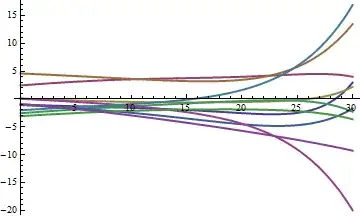I want to forecast tourist arrivals using time series analysis.
I expected to use monthly data from 2000-2013. But due to the civil war, the trend was changed after 2008 as in the following plot.

These are the data in Comma Separated Value format containing the monthly observations by rows, respectively for each year:
Year,1973,1974,1975,1976,1977,1978,1979,1980,1981,1982,1983,1984,1985,1986,1987,1988,1989,1990,1991,1992,1993,1994,1995,1996,1997,1998,1999,2000,2001,2002,2003,2004,2005,2006,2007,2008,2009,2010,2011,2012,2013
Jan,9386,10915,11740,15627,17569,23114,28366,36108,45168,40932,49104,33546,28814,32890,25446,20400,12962,26592,28932,35730,42726,45402,45987,30957,32652,37224,44379,43311,44187,28296,40647,49950,38187,52103,56553,56916,38468,50757,74197,85874,110543
Feb,8343,9648,10388,15214,18064,22427,25226,33896,39384,40148,44018,32406,27012,30512,23714,19150,12344,26368,28080,38859,40116,41067,42591,29550,35010,35283,41526,43287,46575,31683,39081,43584,36645,52687,43051,40551,34169,57300,65797,83549,113968
Mar,7875,9847,11158,13431,18216,20497,25472,34416,38376,42178,44710,32628,29886,28932,22838,19430,16032,26946,27153,33399,37953,41277,40074,26442,34098,32256,41022,40110,44290,33084,40818,38418,50418,54746,35031,38049,34065,52352,75130,91102,113208
Apr,5468,6400,5890,8886,9891,11545,18847,21806,28568,29606,32556,23684,19778,19262,16238,13834,12312,22788,20541,28410,29589,28080,33756,20376,26907,25578,34443,33642,36906,27057,33714,30672,42261,49776,33039,29747,26054,38300,63835,69591,80737
May,4168,3241,5587,6097,7602,8803,13042,19468,21642,28972,32850,18224,14014,13100,8204,11124,12750,18286,17745,21024,22368,21777,24672,17655,22407,20394,25212,23404,26924,26661,30048,30162,40878,43825,26307,31140,24739,35213,48943,57506,74838
Jun,3246,3303,4787,4550,5536,7134,10674,15082,16836,25772,24350,17866,11092,9536,7650,11540,11630,18050,17394,23157,20412,21399,22416,19668,23160,22410,26184,21825,28323,26355,31836,32119,45699,44066,30810,27960,30234,44730,53636,65245,90279
Jul,5919,5404,5925,4278,9881,13252,16801,22986,28266,30942,25132,26694,18362,12330,10200,17660,15194,26410,30645,33771,32904,35370,35994,25380,30867,29529,33288,33267,28566,35742,43743,50525,56745,55354,44142,32982,42223,63339,83786,90338,107016
Aug,6680,6147,8565,3481,11129,15542,20203,27440,32788,34332,8430,27626,20138,15190,11408,18670,17220,26786,28824,40143,32796,32817,35814,24765,32034,31446,39081,34422,15717,35475,42111,48675,51216,52931,44742,30672,41207,55898,72463,79456,123269
Sep,4184,4986,5287,6707,7594,10245,14798,19962,24086,29754,10050,21764,15242,12398,10072,14980,14264,22438,24762,29838,27495,31062,30828,23211,29793,31653,33915,31035,11758,32982,36054,51525,43536,38485,37104,29529,37983,47339,60219,71111,90339
Oct,5977,6199,7622,10636,11541,14340,19376,23646,27030,30296,16410,25800,18176,12732,12146,16742,15050,23060,25173,32079,30621,33216,30603,23511,28314,31767,35112,26658,12904,36258,49922,59442,44095,38815,37011,35103,37575,52370,69563,80379,107058
Nov,7137,8338,11271,13600,17106,20759,25743,23988,29512,33748,20570,27906,23218,18114,14188,10560,18948,24596,28272,35967,35103,33306,28365,24921,31995,38421,41952,32469,17344,37395,54946,64971,48457,37591,45102,36901,44311,72251,90889,109202,109420
Dec,9505,10583,14984,16464,19536,24934,31616,37982,39086,40550,29350,29590,31724,25110,20516,8572,26026,35568,40182,41292,40167,42738,32001,35829,38928,45102,40326,36984,23300,42183,57722,66159,51171,39224,61116,48925,56862,84627,97517,122252,153918
Should I use data ONLY from 2009-2013?
According to this book "A good model will allow for changing trend and changing seasonal patterns." So is there a really problem in using data from 2000-2013?
I'd be grateful if anyone can help me in this problem
Thank you